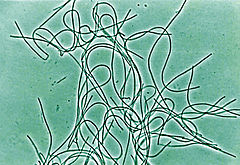- Chloroflexi (class)
-
Chloroflexi 
Chloroflexus Scientific classification Domain: Bacteria Phylum: "Chloroflexi" Class: Chloroflexi Orders "Herpetosiphonales"
ChloroflexalesChloroflexi is one of four classes of bacteria in the phylum Chloroflexi, known as filamentous green non-sulfur bacteria. They produce energy from light and are named for their green pigment, usually found in photosynthetic bodies called chlorosomes.
Chloroflexi are typically filamentous, and can move about through bacterial gliding. They are facultatively aerobic, but do not produce oxygen in the process of producing energy from light, or phototrophy. Additionally Chloroflexi have a different method of phototrophy (photoheterotrophy) than true photosynthetic bacteria. Phylogenetic analysis indicates that they had a separate origin.[clarification needed]
Whereas most Bacteria, in terms of diversity, are diderms and stain Gram negative with the exception of the Firmicutes (low CG Gram positives), Actinobacteria (high CG gram positives) and the Deinococcus-Thermus group (Gram positive, but diderms with thick peptidoglycan), the members of the phylum Chloroflexi are monoderms and stain mostly Gram negative.[1]
Contents
Taxonomy
See also: Bacterial taxonomyThe currently accepted taxonomy is as follows:[2]
- Order Chloroflexales
- Family Chloroflexaceae
- Genus Chloroflexus Pierson and Castenholz 1974
- C. aggregans Hanada et al. 1995
- C. aurantiacus Pierson and Castenholz 1974
- Chloronema Dubinina and Gorlenko 1975
- Chloronema giganteum Dubinina and Gorlenko 1975
- Genus Heliothrix Pierson et al. 1986
- Heliothrix oregonensis Pierson et al. 1986
- Genus Roseiflexus Hanada et al. 2002
- Roseiflexus castenholzii Hanada et al. 2002
- Genus Chloroflexus Pierson and Castenholz 1974
- Family Oscillochloridaceae
- Genus Oscillochloris Gorlenko and Pivovarova 1989 emend. Keppen et al. 2000
- O. chrysea Gorlenko and Pivovarova 1989
- O. trichoides (ex Szafer) Gorlenko and Korotkov1989 emend. Keppen et al. 2000
- Genus Oscillochloris Gorlenko and Pivovarova 1989 emend. Keppen et al. 2000
- Family Chloroflexaceae
- Order Herpetosiphonales
- Family Herpetosiphonaceae
- Genus Herpetosiphon Holt and Lewin 1968
- H. aurantiacus Holt and Lewin 1968
- H. geysericola (Copeland 1936) Lewin 1970
- Genus Herpetosiphon Holt and Lewin 1968
- Family Herpetosiphonaceae
Additionally, there are "Kouleothrix aurantiaca" and "Dehalobium chlorocoercia" which have not been fully described.
Etymology
The name "Chloroflexi" is a Neolatin nominative case masculine plural of "Chloroflexus", which the name of the first genus described. The noun is a combination of the Greek adjective chloros, -a, on (χλωρός, -ά, -όν)[3] meaning "greenish-yellow" and the Latin masculine passive perfect participle flexus (of flecto)[4] meaning "bent" to mean "a green bending".[5] It should be therefore noted that the etymology is not due to chlorine, an element (dephlogisticated muriatic acid air) which was confirmed as such in 1810 by Sir Humphry Davy and named after its pale green colour.
External links
- PubMed references for Chloroflexi
- PubMed Central references for Chloroflexi
- Google Scholar references for Chloroflexi
Further reading
- Garrity GM, Holt JG (2001). "Phylum BVI. Chloroflexi phy. nov". In D.R. Boone and R.W. Castenholz, eds.. Bergey's Manual of Systematic Bacteriology Volume 1: The Archaea and the deeply branching and phototrophic Bacteria (2nd ed.). New York: Springer Verlag. pp. 169. ISBN 978-0387987712.
References
- ^ Sutcliffe, I. C. (2010). "A phylum level perspective on bacterial cell envelope architecture". Trends in Microbiology 18 (10): 464–470. doi:10.1016/j.tim.2010.06.005. PMID 20637628.
- ^ Classification of Chloroflexi entry in LPSN [Euzéby, J.P. (1997). "List of Bacterial Names with Standing in Nomenclature: a folder available on the Internet". Int J Syst Bacteriol 47 (2): 590-2. doi:10.1099/00207713-47-2-590. ISSN 0020-7713. PMID 9103655. http://ijs.sgmjournals.org/cgi/reprint/47/2/590.]
- ^ χλωρός. Liddell, Henry George; Scott, Robert; A Greek–English Lexicon at Perseus Project
- ^ Lewis, Charlton T. and Charles Short, A Latin Dictionary. Oxford: Clarendon Press, 1879. Online version at Perseus
- ^ George M. Garrity, ed (July 26, 2005) [1984(Williams & Wilkins)] (in English). Introductory Essays. Bergey's Manual of Systematic Bacteriology. 2A (2nd ed.). New York: Springer. pp. 304. ISBN 978-0-387-24143-2. British Library no. GBA561951. http://www.springer.com/life+sciences/book/978-0-387-24143-2.
External links
Prokaryotes: Bacteria classification (phyla and orders) G-/
OMTerra-/Glidobacteria (BV1)Eobacteria (Chloroflexi, Deinococcus-Thermus) · Cyanobacteria · Thermodesulfobacteria · thermophiles (Aquificae · Thermotogae)Proteobacteria (BV2)BV4SphingobacteriaOther GNAcidobacteria · Chrysiogenetes · Deferribacteres · Fusobacteria · Gemmatimonadetes · Nitrospirae · Synergistetes · Dictyoglomi · LentisphaeraeG+/
no OMFirmicutes
(BV3)Actinobacteria
(BV5)Actinomycineae: Actinomycetaceae
Corynebacterineae: Mycobacteriaceae · Nocardiaceae · Corynebacteriaceae
Micrococcineae: BrevibacteriaceaeOther subclassesCategories:- Bergey's volume 1
- Phototrophic bacteria
- Order Chloroflexales
Wikimedia Foundation. 2010.
